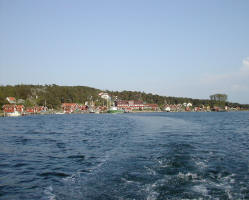|
||||||
|
Interesting Places
Canals
Taking a boat or a canoe on one of Sweden's canals will undoubtedly be a highlight of your holiday. The Göta Canal is the most well known canal, but there are also many other canals that can offer a range of adventures. Combining a number of canals into a round trip is also an option.
The following canals are open for tourists: Bergslag's Canal, Dalsland's Canal, Göta Canal, Hjälmare Canal, Kinda Canal, Strömsholm's Canal, Säffle Canal, Södertälje Canal, Trollhätte Canal, Åker's Canal. |
|
| National Parks
The aim of National Parks is to both preserve nature and provide recreational opportunities. Sweden's first National Parks were set up as early as 1909, and there are presently 28 of them. The latest addition is Fulufjället in North-West Dalarna, which joins the recently inaugurated Söderåsen in Skåne and Färnebofjärden in Nedre Dalälven. The National Parks represent a variety of forms of nature such as mountains, primeval forest, marshlands, archipelago and cultural heritage landscapes. Characteristic landscapes are to be preserved for future generations whilst visitors shall be able to enjoy the tranquillity and natural surroundings.
Swedish law stipulates that National Parks must represent the different forms of landscape which are to be preserved in their natural state, as well as areas of unique natural beauty that provide profound experiences of nature. The idea is also to provide people with the opportunity of getting out in the forests and countryside. Most National Parks have hiking trails and some include information centres. Some also offer overnight accommodation.
The country's first nine National Parks were created in 1909 as the first of their kind in Europe. Sarek and Padjelanta in Lapland are Sweden's two largest National Parks at 200,000 hectares each. Mountain scenery covers almost 90% of the parks' total area.
Regulations vary in the National Parks, but generally speaking the rule "don't disturb and don't destroy" applies, which incidentally also applies to all Swedish countryside and is stipulated in the Swedish Right of Public Access Act. In many parks it is forbidden to light a fire, camp or walk a dog without leash. Stones and plants may not be collected, although it is perfectly legal to pick berries and mushrooms, as it is in other areas. Sweden also boasts a large number of nature reserves and conservation areas in addition to the National Parks. In total, a little over 8% of Sweden is nature conservation land.
Naturist camping
Sweden has been blessed with around 8,000 km of coastline, and around 96,000 lakes and watercourses with a total length of 60,000 km. There are large forests and extensive mountain ranges where much of the land comes under the protection of National parks or nature reserves. Add to this the fact that almost 90% of Sweden's population live in urban areas and you have a very large uninhabited land area, most of which falls under the jurisdiction of the Swedish Right of Public Access. This means that Sweden can offer masses of opportunities for naturists! Open-air bathing areas that are classified for use by naturists are often situated about a 5 or 10 minute walk away from where you park the car. But on the other hand, you can bathe naked virtually anywhere.
Skandinavian Naturist Guide, which can be purchased by paying SEK 60 (for those living in the Nordic countries, SEK 80 for all others) to Sweden's Naturist Association's Post giro (63 69 45 - 8), includes information on camping sites and beaches as well as nudist associations throughout Scandinavia. The guide is in Swedish and English.
Cabins
The red cabin is synonymous with Sweden for many people. Cabins actually come in all colours. The cabin represents an individual and economical type of holiday housing as they can be rented from SEK 2,000 per week. You can select from a single cabin by the lake, with your own boat and close to the forest and with a long distance between you and your closest neighbour, or in a cabin in the middle of a holiday village where your kids can easily find new playmates. The cabins are usually privately owned, which means each cabin has its own special charm, but this also means that the quality and standard varies a lot; you could stay at a more luxurious cabin with Jacuzzi and sauna or at a simple cabin with outside toilet and no electricity. However, most cabins have a modern kitchen with cooker, fridge, plates etc, large living room with colour TV and bedrooms with comfortable beds.
You will find a list of operators offering cabin holidays under the heading Tour operators in the left menu. |
|

